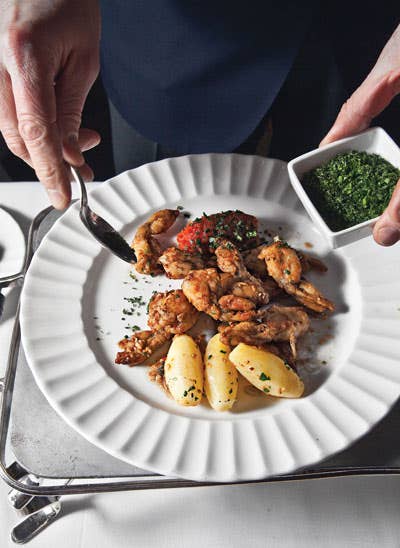
As the sun drops behind the sweet gum trees on a bend of the West Pearl River, 30 miles northeast of New Orleans, a night chorus begins. Hidden in the razor grass, Rana catesbiana, colloquially known as the North American bullfrog, bellows his territorial tune. As three camouflaged pontoon boats are loaded with gear—nets, flashlights, coolers of Abita beer—I stand on the dock and breathe in the tannic scent of this slow-moving tributary of the Mississippi. It's a humid summer evening on the Louisiana bayou and I'm going frog hunting with the New Orleans chef John Besh, who was raised beside this cypress swamp, and some of his friends. Later, we'll head back to this fish camp with a burlap "croaker sack" full of frogs and cook up a late-night supper with our catch.
This nocturnal ritual, or one like it, has taken place for millennia wherever wetlands are the prevalent terrain. Fossils from the Neolithic age suggest we've been eating frogs for more than 5,000 years, and they remain one of the world's truly international proteins, found in recipes for everything from frog soup in Singapore to frog stew in Indonesia, but it's the creatures' meaty, tender hind legs that have inspired some of the most delicious creations. In Vietnam, they're dusted with curry powder and stir-fried with lemongrass; in northern Italy, they often show up fried or in risottos. Frogs' legs are simmered with chiles, garlic, and cilantro in Mexico's Veracruz state, and they're venerated in Cantonese cuisine, where the sweet, delicate meat goes into restorative congees, or rice porridges. And in this country, you'll find them, often deep-fried, everywhere from Southern church suppers to the famous Nathan's hot dog stand on Coney Island.
But no culture is identified so closely with, or has devised so many dishes for, frogs' legs as that of the French, whose indefatigable appetite for the food gave rise, back in the 16th century, to the famous Anglo-Saxon habit of calling the French "frogs." The earliest recorded recipe for cuisses de grenouille, as frogs' legs are called in France, appears in a 1393 cookbook titled Le Menagier de Paris, or "The Goodman of Paris"; the recipe calls for simply frying the thighs in oil. Since then, frogs' legs have been prized by France's greatest chefs. In his 1832 tome L'art de la cuisine française, Marie-Antonin Careme recommended dressing them in an egg yolk-and-cream sauce. In 1908 Georges Auguste Escoffier caused a sensation when he served Albert Edward, Prince of Wales, cuisses de nymphes a l'Aurore, or thighs of the dawn nymphs, at the Savoy Hotel. (Escoffier apparently found the English translation of cuisses de grenouille too vulgar to print on a menu.) And, upon winning his third Michelin star in 1967 at L'Auberge de l'Ill, the Alsatian chef Paul Haeberlin created a mousseline de grenouilles, an elegant terrine of deboned and minced leg meat poached in riesling. Today, along with other classics like lobster bisque and escargots, frogs' legs remain a staple of traditional French restaurants.
In fact, one of the most storied French restaurants in this country shares its name with the amphibian. "We wouldn't dream of taking them off the menu," says Charles Masson, the manager of La Grenouille, one of the last bastions of classical French cooking in New York City. For all of its 48 years, the restaurant has served its famous frogs' legs a la provençale (see ** Sauteed Frogs' Legs**): gently sauteed in butter, parsley, and garlic and finished tableside with a squeeze of lemon. The last time I was there, Masson himself directed the service. "This is one of the greatest ways to prepare frogs' legs," he says. "You never get tired of them."
Masson gets his frogs' legs from France, though today you're just as likely to find ones from Vietnam, Bangladesh, Indonesia, and China. In fact, Indonesia is now the world's largest exporter of frozen bullfrogs. Most frogs' legs from Asia come from farm-raised animals belonging to the species Rana tigrina, the Indian bullfrog—a cousin of Rana esculenta, the little spotted green frog that populates Europe's fenlands and inspired Escoffier and his ilk. Bigger and arguably better than both those varieties is our homegrown Rana catesbiana, which can weigh as much as one and a half pounds and reach a length of eight inches. "The American bullfrog is the saber-toothed tiger of amphibians," says Ian Hillier, a marine biologist at New Orleans's Audubon Aquarium of the Americas. "Their skeletons are huge compared with European species, and they eat everything." In the wild, this includes bugs, fish, snakes, and even small birds; because of its diet, wild bullfrog tastes gamier than do those raised on fly meal in aquaculture ponds, where the animals are bred to have milder, whiter-toned meat.
Wild-caught frogs' legs remain a fresh, seasonal indulgence in New Orleans restaurants and in Louisiana home kitchens, where well-thumbed copies of The Picayune's Creole Cook Book rest on shelves next to the cast-iron etouffee pot. That essential book contains no fewer than six recipes for frogs' legs, about which the authors offer the following injunction: "Properly cooked, they are much more delicate than chicken and a great dish at recherche dinners."
It wasn't recherche down by the buggy banks of the West Pearl River the night I spent frogging with John Besh, but there were plenty of live ouaouaron (Cajun French for bullfrog). After we returned to the dock, wet and caked with river mud, I watched as Besh started a cook fire and then coated a mess of frogs' legs with buttermilk, dusted them with cayenne-seasoned flour, and flung them into a vat of boiling peanut oil—a variation on that ancient recipe in Le Menagier de Paris. "This is the best fun a man can have legally," Besh said as he put a few flaky-crusted legs on my plate. I devoured each one in four toothsome bites; the meat was a little chewy, and closer in taste to fish than fowl, with a subtly pungent note that called to mind the frogs' marshy home.
Keep Reading
Continue to Next Story










